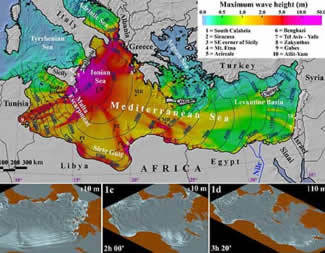Could this have been the origin of the Atlantis mythos/meme?
Scientists: Towering Tsunami Hit Mediterranean 8,000 Years Ago
Italian scientists say geological evidence suggests a giant tsunami resulted from the collapse of the eastern flanks of Mount Etna nearly 8,000 years ago.  The collapse of the volcano, located on Italy's island of Sicily, was studied by Maria Teresa Pareschi and colleagues at Italy's National Institute of Geophysics and Volcanology. They modeled the collapse and discovered the volume of landslide material, combined with the force of the debris avalanche, would have generated a catastrophic tsunami, impacting the entire Eastern Mediterranean.
The collapse of the volcano, located on Italy's island of Sicily, was studied by Maria Teresa Pareschi and colleagues at Italy's National Institute of Geophysics and Volcanology. They modeled the collapse and discovered the volume of landslide material, combined with the force of the debris avalanche, would have generated a catastrophic tsunami, impacting the entire Eastern Mediterranean.
Simulations show the resulting tsunami waves would have destabilized soft marine sediments across the floor of the Ionian Sea.
The study -- entitled "The Lost Tsunami" -- appears in the current issue of the journal Geophysical Research Letters.
A new computer simulation of the ancient event reveals for the first time the enormity of the catastrophe and its far-reaching effects
[video].
The Mt. Etna avalanche sent 6 cubic miles of rock and sediment tumbling into the water—enough material to cover the entire island of Manhattan in a layer of debris thicker than the Empire State Building is tall.
According to Pareschi, if the same tsunami struck today, Southern Italy would be inundated within the first 15 minutes [image]. In one hour, the waves would reach Greece's western coasts. After an hour and a half, the city of Benghazi in Northern Africa would be hit. At the three and a half hour mark, the waves would have traversed the entire Mediterranean to reach the coasts of Israel, Lebanon and Syria.
The researchers have also linked the ancient tsunami with the mysterious abandonment of Atlit-Yam, a Neolithic village located along the coast of present-day Israel. When archeologists discovered the village about 20 years ago, they found evidence of a sudden evacuation, including a pile of fish that had been gutted and sorted but then left to rot.
Lost Civilisations
The implication of the historicist argument is that two highly advanced civilisations – Atlantis and Athens respectively – existed c. 9600 BC. And yet, according to archaeologists, civilisation began much more recently, c. 4000 BC (in the lands of ancient Egypt and Mesopotamia). How, then, could the two fantastic civilisations described by Plato have existed more than five thousand years earlier, during what archaeologists call ‘the neolithic period’? The idea is controversial, to say the least.
| |
A submerged island that could be the source of the Atlantis myth was hit by a large earthquake and tsunami 12,000 years ago, a geologist has discovered. Spartel Island now lies 60m under the sea in the Straits of Gibraltar, but some think it once lay above water. The finding adds weight to a hypothesis that the island could have inspired the legend recounted by the philosopher Plato more than 2,000 years ago. Evidence comes from a seafloor survey published in the journal Geology. Marc-André Gutscher of the University of Western Brittany in Plouzané, France, found a coarse-grained sedimentary deposit that is 50-120cm thick and could have been left behind after a tsunami. |




